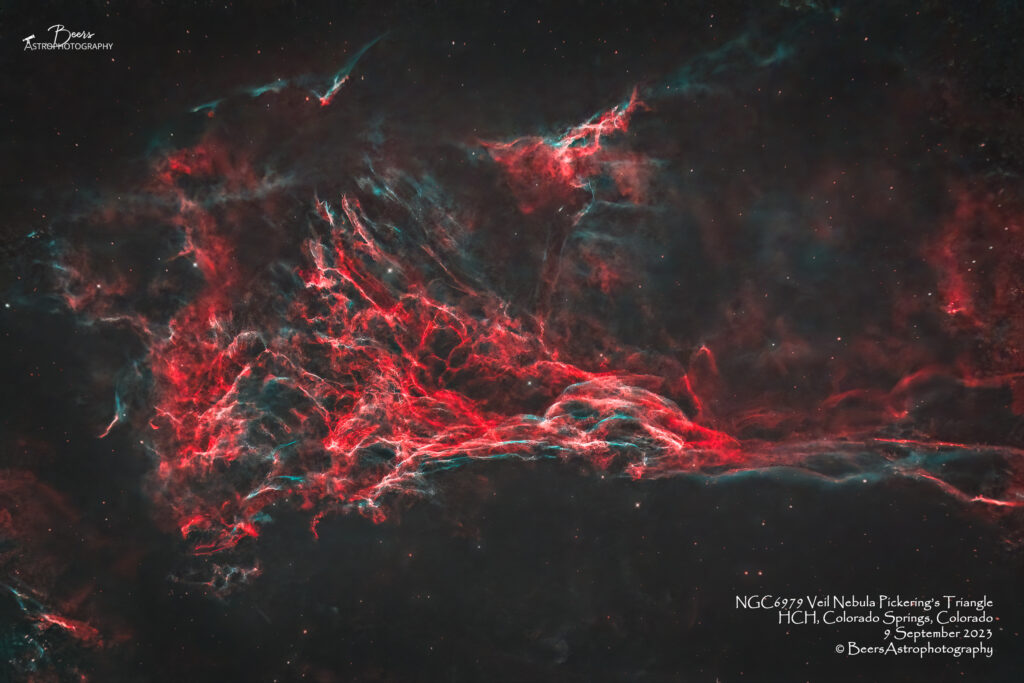
Fun facts
The Veil Nebula is a cloud of heated and ionized gas and dust in the constellation Cygnus. It constitutes the visible portions of the Cygnus Loop, a supernova remnant. In modern usage, the names Veil Nebula, Cirrus Nebula, and Filamentary Nebula generally refer to all the visible structure of the remnant, or even to the entire loop itself. The structure is so large that several NGC numbers were assigned to various arcs of the nebula. This image is Pickering’s Triangle (or Pickering’s Triangular Wisp), brightest at the north central edge of the loop, but visible in photographs continuing toward the central area of the loop. NGC 6974 and NGC 6979 are luminous knots in a fainter patch of nebulosity on the northern rim between NGC 6992 and Pickering’s Triangle (according to Stellarium, NGC6979 is Fleming’s Triangular Wisp thus the choice of nomenclature here).
The full Veil Nebula is shown in the gallery here: https://beersastrophotography.com/gallery/cygnus-loop-veil-nebula-ngc6960-western-veil-witchs-broom-ngc6992-eastern-veil-pickerings-triangle/ The source supernova was a star 20 times more massive than the Sun which exploded between 10,000 and 20,000 years ago. At the time of explosion, the supernova would have appeared brighter than Venus in the sky, and visible in daytime. The remnants have since expanded to cover an area of the sky roughly 3 degrees in diameter (about 6 times the diameter, and 36 times the area, of the full Moon). While previous distance estimates have ranged from 1200 to 5800 light-years, a recent determination of 2400 light-years is based on direct astrometric measurements.
The Hubble Space Telescope captured several images of the nebula. The analysis of the emissions from the nebula indicates the presence of oxygen, sulfur, and hydrogen. The Cygnus Loop is also a strong emitter of radio waves and x-rays.
Other Catalog Designations: NGC6979, NGC6974, Pickering’s Triangle, Pickering’s Triangular Wisp
Subtype: Supernova Remnant
Distance from Earth: 1470 light years
Visual Magnitude: 7.0
Apparent Size: 1º x 8′
Constellation: Cygnus
{From: https://en.wikipedia.org/wiki/Veil_Nebula }
Capture Notes:
This was captured on Saturday night, the last clear night before a long wet, rainy, cloudy, stormy spell (that has cancelled September’s dark sky trip – boo on Mother Nature!) The clouds were forecast (in the three different apps to clear up at either 2100 (WeatherUnderground), 0000 (Astropheric), or not at all (ClearOutside). I went to bed at about 2100 with full cloud cover and set an alarm for 2330 – when I woke up there was a wisp of clouds, but I had hopes that the 0000 prediction was going to be correct, so got up and took the equipment outside and set up, and the process started. Got started with NGC6979 Fleming’s Triangle with the intent to image it until it set at about 0330, then switch to the Jellyfish at about that time to begin gathering data on it until astronomical twilight ended at 0540. NGC6979 was well past the meridian, so the imaging went flawlessly, gathering almost three hours of five minute exposures.
Equipment
Polar alignment: QHYCCD camera (controlled by Polemaster)
Imaging stream: (Big Bertha) Orion 8″ f/8 Ritchey-Chretien Astrograph Telescope, ZWO ASI2400MC#2 imaging camera, Optolong LeXtreme light pollution filter
Mount: SkyWatcher EQ6‑R PRO Synscan mount (controlled by ASCOM driver)
Autoguider: Orion 60mm Multi-Use Guide Scope, Orion StarShoot AutoGuider Pro Mono Astrophotography Camera (controlled by PHD2)
All equipment controlled by Windows 11 HP Probook (DSO-CTRL-2) running Sequence Generator Pro v4.2.0.16.
Capture & processing notes
Sequence plan: Gain: 158, Temp: -0°C, offset=30; 34x5min. Total exposure time: 2:50hrs.
Captured: 10 September 2023; 0026 – 0322MDT
Shooting location: HCH, Colorado Springs, Colorado
Processing: Captured with SGP, stacked in APP, star removal with Starnet++, processing with LR/PS
